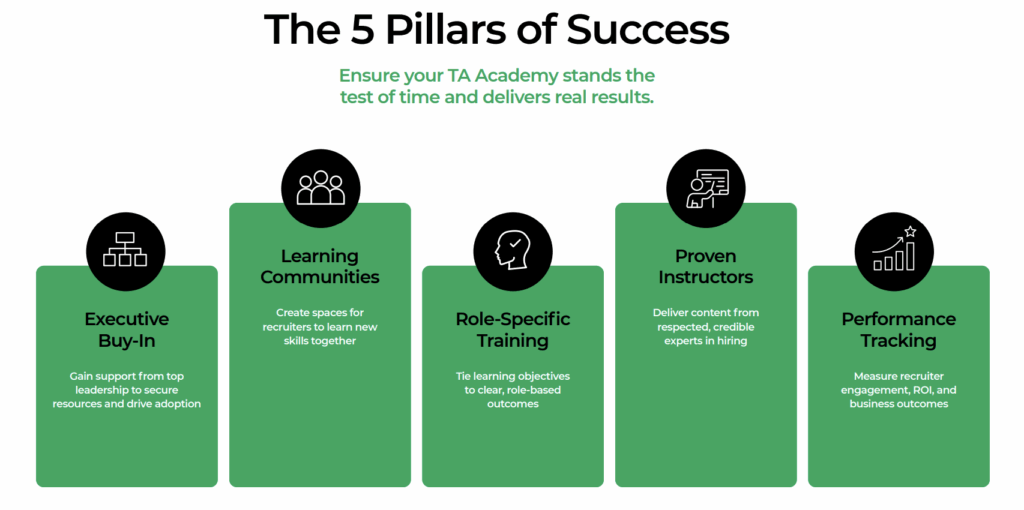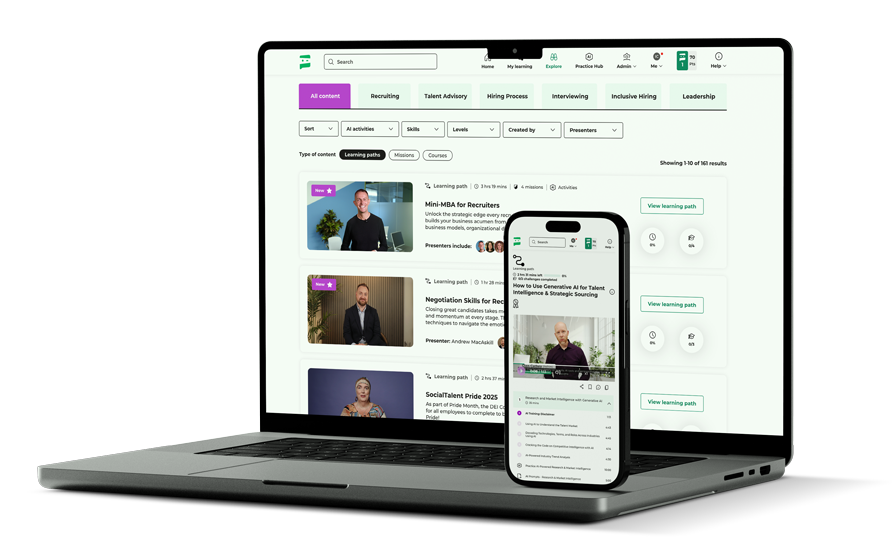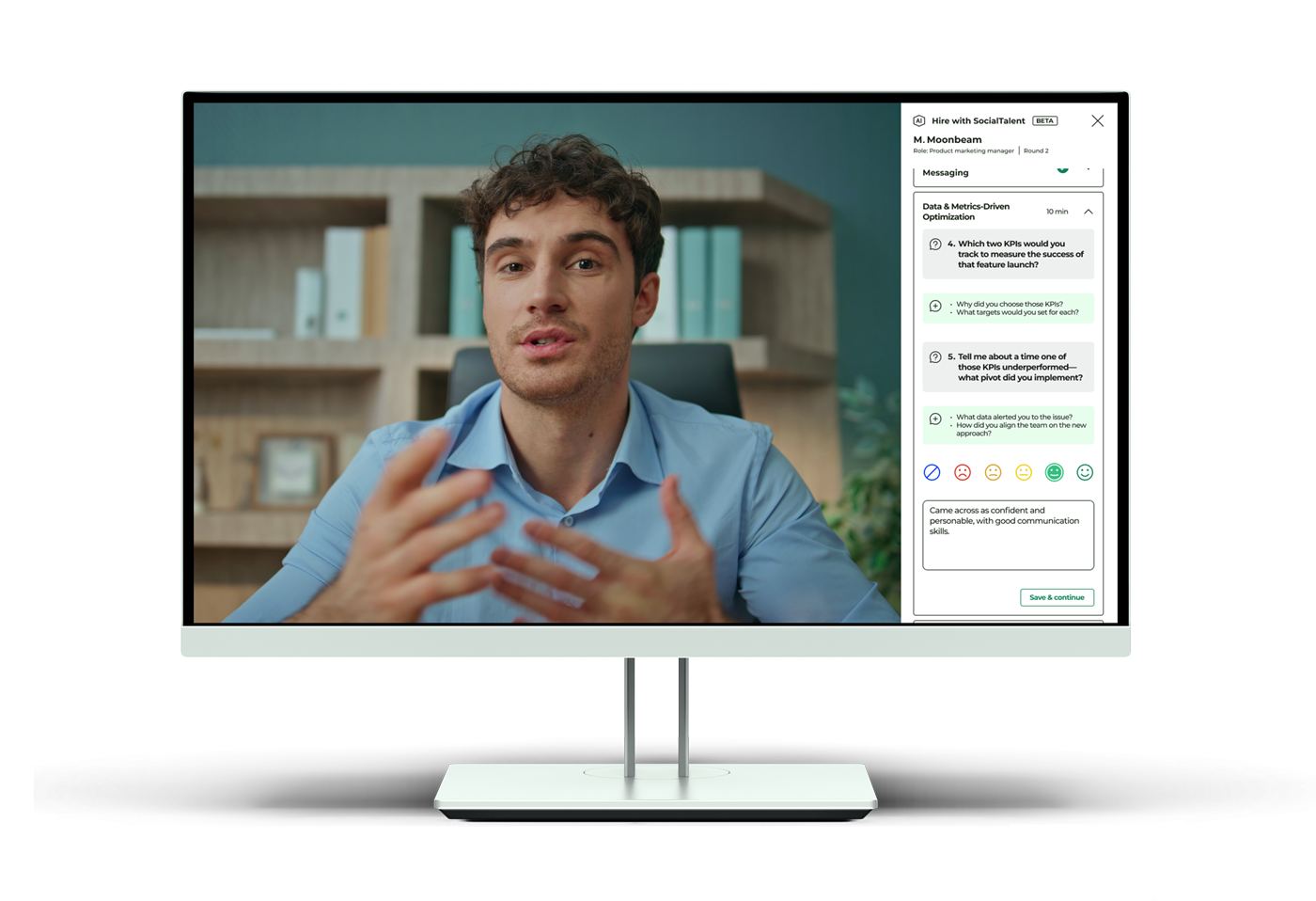
By Johnny Campbell
“We should build a TA Academy.”
Harmless sentence, right? Everyone nods. People get excited. It sounds strategic. Forward-thinking. Responsible even.
But fast-forward a few months and reality sets in:
- Half the team hasn’t logged into the platform.
- The business has moved on to new priorities.
- The rollout plan is a Google Sheet no one owns.
I’ve seen it too many times. And if I’ve learned anything, it’s that building a TA Academy isn’t just a training initiative – it’s a business change. And if you’re not treating it that way, you’re probably wasting time, budget, and goodwill.
Every TA leader I know wants to invest in their team’s development. The intention is always there. But building a scalable, relevant, and actually useful learning ecosystem for recruiters is harder than it looks.
The results, however, can be nothing short of transformative.
The Big Why: Why Now, and Why It’s So Bloody Hard
This isn’t news to anyone but the world of recruiting has dramatically shifted, particularly over the last 5 – 10 years. No longer just filling seats, today’s recruiters are expected to:
- Use AI like a pro,
- Advise hiring managers with market intelligence,
- Partner strategically across the business,
- And still… somehow… get jobs filled quickly.
But we’re still training TA teams like it’s 2014.
The need for recruiter upskilling is obvious to everyone in this climate. But building a program that works – at scale, across regions, tech stacks, and skill levels – is a very different beast.
It’s not just about “delivering training.” It’s about constructing an adaptive system that grows capability in a business that never stands still.
That’s the real tension: you’re building learning while everything around you is moving – roles, priorities, tech, expectations. You’re solving for the now, while preparing for a future that might change shape again in six months. It’s like trying to replace the wheels on a speeding car flying down a motorway and there’s never been so much traffic on the road!
But there is a path forward.
Lesson #1: If It Feels Simple, You’ve Probably Missed Something
SocialTalent has been helping TA leaders to build academies for over a decade across all kinds of industries, and one thing is clear: this isn’t an L&D side project.
It’s a programmatic effort that blends curriculum design, change management, stakeholder buy-in, and culture shift. And the first place most people trip up? The mindset.
Too many programs are reactive. Tools are bought or new recruiters are hired and the kneejerk reaction is to roll out “some sort of training”. But what’s actually needed is a strategic mindset:
- “What skills will define success in TA a year from now?”
- “Where are our biggest capability gaps today?”
- “How do we prepare for AI without overwhelming the team?”
This isn’t about knowing everything in advance. It’s about deliberate planning over accidental patching.
Lesson #2: Don’t Build a House Without Blueprints
One thing every successful TA Academy I’ve studied had in common? A clear, well-defined competency framework.
You can’t build learning if you don’t know what “good” looks like. Most orgs break this down into key pillars – some version of:
- Business Partnering
- Candidate Engagement
- Assessment & Interviewing
- Tech and Tools
- Market Intelligence
Each pillar is layered with learning tracks at different levels – 101, 201, 301, etc. But fundamentally this isn’t just about creating a “junior vs. senior” structure. It’s more about letting people deepen capability over time without needing a promotion to justify it.
Lesson #3: Modularity Isn’t a Buzzword. It’s Survival.
The smartest programs don’t build rigid linear curriculums. They design modular, standalone learning blocks. Why? Because priorities shift. Fast. Especially in this new AI-powered environment.
If Q3 is all about internal mobility, you should be able to roll out learning on stakeholder engagement, redeployment, and internal candidate experience right now. If sourcing becomes a crisis in Q4, you don’t want to wait for people to finish the “Fundamentals of Interviewing” first.
Modularity means agility. You can curate, combine, and push learning based on what’s happening in the business today keeping it hugely relevant. In short, thematic rollouts trump linear paths everyday!
Lesson #4: Don’t Isolate AI. Infuse It
Here’s a common mistake I’m seeing a lot in 2025: creating one “Intro to AI” module and calling it a day. Recruiters don’t need an AI masterclass. They need to see how AI can make them better at the job they already do. That’s why leading TA Academies are weaving AI throughout the curriculum.
Examples we love:
- Recruiters using AI to prepare for meetings with their hiring managers by pulling real-time market data.
- AI training simulations where they negotiate offers with virtual candidates or practice pushback with AI-generated hiring managers – and get feedback instantly.
This isn’t science fiction. It’s already happening (on the SocialTalent platform anyway!) and it’s sticky, scalable, and context-rich.
Learn more: Humans + AI: The Winning Formula For The Future of Recruiting
Lesson #5: If You Forget Managers, You’ll Regret It
One of the most common blind spots in TA Academies? Manager development.
You can train your recruiters till the cows come home but if their managers can’t coach them, reinforce the learning, or even speak the same language, it’ll unravel fast.
Invest in managers as force multipliers: Teach them to coach, give them the performance tools they need, and hold them accountable for creating space for learning.
Learn more: The Biggest Risk in Hiring? It’s Not Your Recruiters…
Lesson #6: Content Strategy Is Hybrid or Bust
Here’s where things get tactical.
Don’t build everything from scratch. Use ready to go, external content for evergreen topics like sourcing fundamentals, structured interviewing, DEI basics, etc. But don’t rely entirely on it either. To make a TA Academy truly sing, you’ll need to create or source your own bespoke content for things like:
- Your internal tools (e.g., your actual ATS)
- Company-specific processes and values
- Cultural context and legal compliance by region
It’s a hybrid model. Buy what’s universal, build what’s unique.

Lesson #7: Global Teams Need Local Thinking
Designing a central program is great, but ignoring local nuance will kill it. You need:
- Flexibility to localize content (e.g., works council compliance in Germany)
- Ability to slot in region-specific modules or case studies
- A platform that supports language variation and legal frameworks
Think global. Build flexible. Launch local.
Lesson #8: Don’t Push Everything to Everyone
One common fantasy we always come up against when partnering with organizations is around the noble desire to create individualized learning plans for every recruiter.
The reality? That doesn’t scale.
Better solution: Use recommendation engines in your learning platform. Based on role, self-identified goals, or skill assessments, the system suggests what’s next. This allows recruiters to self-direct within smart constraints, and ultimately lets your data guide relevance.
Lesson #9: Measure What Matters
Here’s the brutal truth: just because someone completed a module doesn’t mean they learned anything – let alone changed behavior. You need a deeper lens.
Quantitative metrics:
- Time-to-shortlist
- Interview-to-offer conversion
- Offer acceptance rates
Qualitative signals:
- Hiring manager feedback linked to learned behaviors
- Recruiter confidence and perception of manager coaching
- Survey data tied to specific learning outcomes
And if you can connect it all to business performance? You’ve just future-proofed your Academy’s budget.
Learn more: Here’s the Talent Advisor ROI
And Finally: Link Learning to Careers
If you really want to spur on adoption? Connect the dots between learning and advancement.
- Completion of certain learning levels could unlock promotion eligibility.
- Advanced tracks might tie directly to readiness for senior recruiter or manager roles.
- Badges or credentials can signal internal expertise.
Make learning part of career identity, not just compliance.
Building a TA Academy Is Hard But Worth It
This isn’t a sprint. And it’s definitely not a singular project.
A real TA Academy is a living system. One that reflects the business, flexes with market changes, and equips your people to thrive – not just now, but next year, and the year after that.
Content is only one element of this. Really, it’s about having and maintaining an enablement engine. So here’s my question to you:
If your recruiting team is your engine – what are you doing to keep it running sharp?




